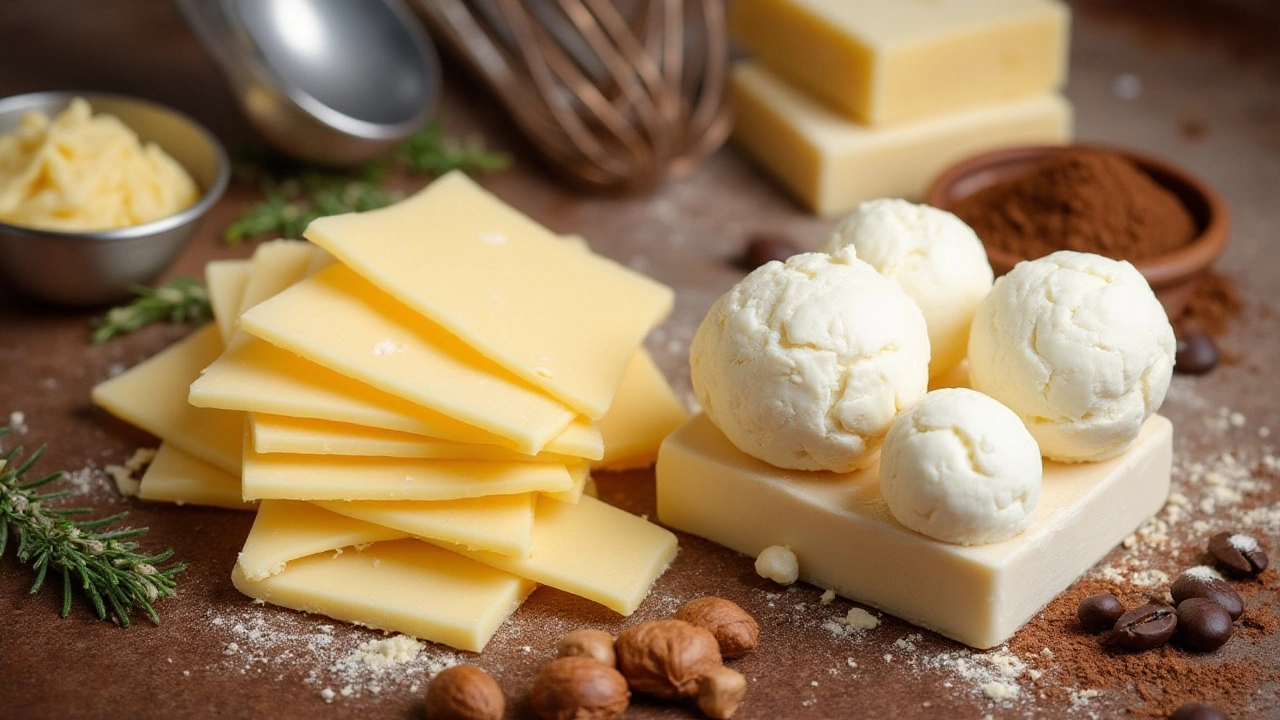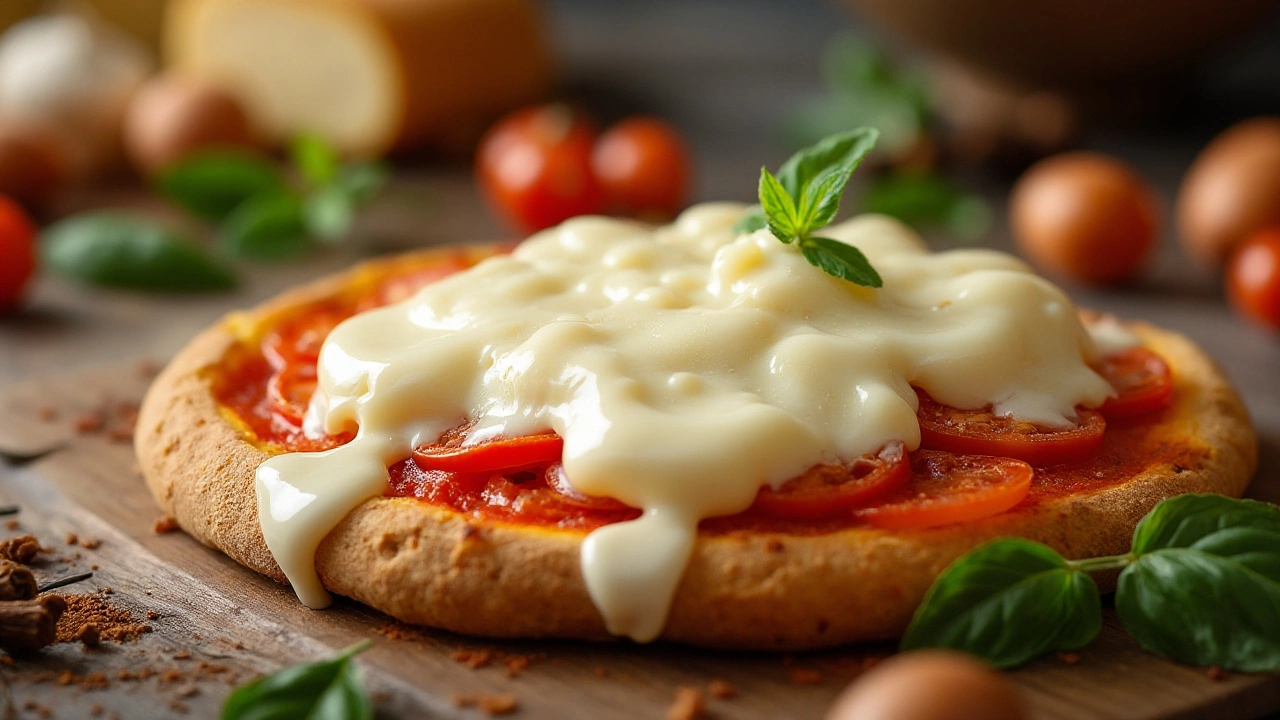
Have you ever stood in the cheese aisle pondering which cheese would melt most beautifully into your culinary creation? If you're preparing a dish that requires silky smooth cheese, knowing the ins and outs of your options—like Prato and Mozzarella—can make all the difference.
In the world of cheese, it's not just about the flavor. While a tangy bite is delightful, when we're talking meltability, Prato and Mozzarella take center stage for their unique characteristics that impact dishes from tiramisu to gourmet bakes. Understanding these differences can help elevate your kitchen prowess.
As we navigate through the peculiar melting properties of these beloved cheeses, you'll gain insights into how to choose and use the perfect cheese that complements your recipes. Whether you're crafting the classic Italian tiramisu or experimenting with new cheese-infused recipes, the right cheese is key.
- Understanding Cheese Melting Properties
- Profile of Prato Cheese
- Characteristics of Mozzarella Cheese
- Taste and Texture Impact on Dishes
- Cheese Melting Tips for Home Cooks
- Choosing the Right Cheese for Tiramisu
Understanding Cheese Melting Properties
If you've ever watched your favorite cheese bubble and melt under the oven's broiling heat, you'll agree that melting cheese is something of a kitchen magic. But what exactly makes Prato or Mozzarella the stars of this alchemical show? Understanding why certain cheeses melt the way they do involves a mix of science and artistry. It all starts in the laboratory of the cheesemaker, where ingredients like milk type, cultures, and curd treatment dictate the future meltability of the cheese. High-moisture contents and particular coagulation methods often lead to cheeses that melt into gorgeous, stretchy pools perfect for any tiramisu layered treat.
Now, imagine you are in your kitchen, dreaming of creamy tiramisu layers. Knowing that the cheese you choose will align with your taste and texture preferences, you can make an informed choice. Prato cheese, known for its semi-soft and buttery texture, owes its wonderful melting ability to its fat and water content. This makes it an excellent contender for dishes that require a smooth and even melt. Mozzarella, on the other hand, brings a famous stretchiness and richness, a favorite among those who enjoy a more delicate melt. Traditionally, Mozzarella boasts a lower moisture content, which affects how quickly and smoothly it melts, turning your dish into a melted wonderland.
The Art of Cheese Choice
Selecting the right cheese isn't just about its melting prowess. It is also about harmonious flavor integration. When choosing between Prato and Mozzarella for your next dish, consider the overall flavor profile you want. The savory zing of Mozzarella may add a more robust cheese flavor to your culinary imagination, whereas Prato's milder nature allows for a more subdued yet effortlessly creamy blend. Connoisseurs often discuss this melting ability like a fine art. As cheese author and expert Steven Jenkins echoes,
Certain cheeses melt better due to their fat content and water percentage. It’s all about understanding their characters in detail.
Scientific Cheese Structure
Cheese scientists and makers have enough knowledge to unravel the mystery behind cheese melting behaviors, focusing on their structural complexities. Cheese is essentially an emulsified matrix of fat and proteins interspersed with water. When heat is introduced, this matrix breaks apart. High-fat cheeses with fine protein networks, like Mozzarella, slide into their melting stage much faster, creating that sought-after gooeyness. If a cheese's protein structure is too tight, or its moisture content insufficient, it may become oily and separate rather than melt smoothly, a crime to cheese lovers everywhere.
| Cheese Type | Fat Content (%) | Water Content (%) |
|---|---|---|
| Mozzarella | 22 | 50 |
| Prato | 24 | 44 |
As seen in the table, the difference in fat and water content between these two cheeses gives them distinct melting qualities. Understanding these structural properties of cheese might just transform your cooking, as you harness the best melting capabilities to suit your every dish. While you craft your own masterpiece, remember that each cheese brings its own personality to the recipe, just like a well-orchestrated symphony.
Profile of Prato Cheese
Originating from the lush landscapes of Brazil, Prato cheese is a delightful blend of Danish inspiration and local adaptation that has become a household name in the South American country. This semi-hard cheese, etching its place in culinary history, boasts a mild buttery flavor with a subtle hint of nuttiness. It’s these mellower tones that make it an excellent companion for recipes demanding a harmonious, not overly intrusive cheese presence—notably dishes like tiramisu where blending is integral. As it melts, Prato's slices offer a creamy texture that pairs beautifully with numerous ingredients, complementing without overpowering them.
Prato cheese features a smooth, yellowish exterior with uniform holes scattered throughout its interior, similar to Gouda. Its versatility allows it to melt smoothly, ensuring a consistent coating, whether it's layered or mixed within a dish. Given its accessible melting point, Prato fits perfectly into dishes that require a uniform cheese spread without the fuss of uneven clumping. Yet, its appeal is not restricted to taste or textural properties. Prato is revered for its nutritional benefits, offering a good source of calcium and protein, essential for bone health and muscle maintenance, respectively.
The history behind Prato is just as rich as its flavor. Introduced by Danish immigrants in the 1920s, the cheese captivated Brazilian taste buds so swiftly that production spread like wildfire across the country, establishing its permanent presence in Brazilian gastronomy. A testament to its popularity is the annual growth in production noted by local dairy associations, which reinforces its status as a staple kitchen ingredient. It's no wonder that chefs and home cooks alike often reach for this cheese when seeking reliable quality and taste.
Why Prato Melts Beautifully
What contributes to the magnificent melting prowess of Prato is its balanced moisture content combined with ideal fat ratios. These characteristics ensure that when subjected to heat, the cheese doesn’t separate or become greasy, retaining the desired creamy texture that can turn a dish into a mouth-watering masterpiece. In fact, a study highlighted in the 'Journal of Dairy Science' recognizes Prato among a select group of cheeses praised for melting quality—a testament to its use as a bountiful base for recipes both traditional and modern. As one cheesemaker reportedly mentioned,
"Prato doesn't just melt; it gracefully embraces every other element in the dish."

Characteristics of Mozzarella Cheese
Mozzarella cheese, a staple in the culinary world, is celebrated for its unique ability to melt into a creamy, stringy consistency that makes it a popular choice for a variety of dishes. Originating from Italy, the traditional mozzarella is crafted from water buffalo milk, although now cow's milk is commonly used, especially in the U.S. This cheese is unripened, lending it a soft, moist texture that is unlike aged hard cheeses. Its flavor profile is mild and slightly tangy, making it versatile enough to complement both savory and sweet dishes. Interestingly, mozzarella's high moisture content plays a key role in its melting properties, as it allows the cheese to create those delightful strands as it heats, which is an iconic feature when used in classic eats like pizza and lasagna.
A fascinating aspect of mozzarella is its nutritional makeup, which supports its creamy texture. It is relatively low in fat compared to cheeses like cheddar, yet retains enough lactose to contribute to its sweetness. Mozzarella is also a source of calcium, essential for bone health, making it not just a delicious choice but a nutritious one as well. Notably, fresh mozzarella, often sold in brine or whey, offers a different experience than the packaged, shredded versions found at supermarkets. These fresh balls provide an authentic approach to using mozzarella, ensuring maximum flavor and melting qualities. A chef once noted, "Choosing the freshest mozzarella can transform a dish from great to unforgettable, shaping the texture and taste like no other cheese can."
The production process of mozzarella is distinguished by its unique stretching technique, known as pasta filata. This method involves heating the curds in hot water and then stretching and kneading until smooth. This contributes to the cheese's elasticity and meltability. When considering the inclusion of mozzarella in recipes, its moisture content is crucial. It’s also interesting to note that mozzarella's ability to melt beautifully is affected by both its diet and the region it comes from, as these factors influence the milk's quality. Whether you’re topping a homemade pizza or experimenting with innovative fusion dishes, understanding the characteristics of mozzarella can elevate your Tiramisu and other culinary creations.
Taste and Texture Impact on Dishes
The taste and texture of cheese play a pivotal role in culinary outcomes, especially in dishes where cheese is the star attraction. Prato cheese, with its semi-hard structure, introduces a unique buttery flavor that impresses with a faint sweetness. Such qualities make it a delightful companion in dishes requiring a creaminess without overpowering other ingredients. A fascinating aspect of Prato is its ability to complement dessert dishes like tiramisu, adding a subtle depth that surprises the palette.
On the other hand, Mozzarella is often celebrated for its unrivalled melting properties and mild flavor, making it a versatile choice in both savory and sweet recipes. This white cheese, known for its elastic texture when melted, provides that classic stretch that many crave in cheese-infused dishes. Its mild nature allows it to absorb surrounding flavors, making it an ideal base rather than a dominant ingredient. The texture, once melted, is smooth and cohesive, which is why Mozzarella is favored in baking and casseroles.
The choice between Prato and Mozzarella can ultimately depend on the desired flavor and texture outcome. Interestingly, a well-melted cheese can play a surprising role in not just flavor, but also the overall mouthfeel of a dish. Culinary experts often recommend considering the inherent salty or sweet profiles of each cheese when choosing which to use in a dish. This choice can redefine a recipe, turning something basic into an extraordinary experience.
Trying to take your dish to the next level by mixing different varieties of cheese can create unique flavor combinations and textures. As quoted by Julia Child, "With enough butter, anything is good." The same can be said for cheese—explore combinations, and don't be afraid to experiment.
Textural Influence in Cooking
Texture plays an equally essential role in complementing dishes. Cheeses like Prato offer a weave of flavors and textures that can transform a dish's profile when incorporated creatively. The softness and pliability of Mozzarella, when heated, melds brilliantly with ingredients, binding them together while adding a chewy bite that accentuates the overall dish. It's this nuanced textural quality that often dictates whether a cheese is chosen for particular recipes, or how it marries with expected flavors such as those in traditional tiramisu.

Cheese Melting Tips for Home Cooks
For many home cooks, achieving the perfect melt can make or break a dish. Understanding the properties of melting cheese, particularly popular choices like Prato and Mozzarella, is essential for any kitchen enthusiast. When you think about a creamy sauce or a gooey topping on your lasagna, the question isn't just about flavor dominance; it's about which cheese melts smoothly and evenly. Mozzarella, renowned for its oozy texture, excels in dishes where elasticity is desired. In contrast, Prato offers a different melting profile, suited for those looking for richness without excessive stretch. Knowing the right cheese begins with understanding your dish's texture requirements and cooking conditions.
Temperature is a key player in cheese melting. High temperatures can ruin delicate proteins in cheese, leading to a split or grainy texture. To avoid this, consider low and slow heat, especially when using a cheese like Mozzarella anticipated in traditional dishes like tiramisu. When melting cheese, using a double boiler can help maintain a consistent, gentle heat, promoting an even melt without overheating the cheese's fats. Another trick is grating the cheese finely; it allows for quicker, more uniform melting, significantly when cooking over direct heat. Watch the timing as precisely melted cheese can transform an ordinary meal into something extraordinary.
Fat and moisture content also play a crucial role. A cheese with higher fat will generally melt better, as the fat prevents the proteins from clumping together which Prato cheese provides in spades due to its origins in the semi-hard cheese family. Knowing this, pairing it in meals where richness is appreciated, like simply layered gratins, can harness its full potential. Many culinarians suggest softening your cheese by allowing it to reach room temperature before cooking, particularly if you plan to incorporate it into cold dishes or integrate them slowly into sauces. According to food scientist Harold McGee, "The fat and water in cheese determine how it melts. More water and fat make for a smoother melt." Remembering this balance can be your secret weapon.
Also important is balancing the cheese with other ingredients. Think about using acids like lemon juice or vinegar to soften the proteins in cheese, enhancing the melt quality. Particularly in a dish like tiramisu, where bold flavors complement the creaminess, mixing sweet with savory can be a delightful turn. If desiring an inventive twist, try blending cheeses to exploit different qualities: a hint of gooey Mozzarella with robust Prato can be a powerful combination in reinforcing a flexible melt while also keeping texture and flavor intact. This technique not only elevates a recipe but ensures a comprehensive flavor distribution in each bite.
Lastly, one trick is embracing some unconventional methods like adding a little cornstarch or sodium citrate when making cheese sauces. These ingredients can help maintain the emulsion, preventing the melt from becoming too oily or clumpy, especially when crafting something like a bechamel-based layer for lasagna. Using this method can help stabilize the mixture, leading to a smoother presentation. These tips and techniques, peppered with creativity, are bound to enhance your experience with melting cheese.
Choosing the Right Cheese for Tiramisu
When it comes to tiramisu, many consider whether to use Mozzarella or Prato cheese somewhat unconventional. But experimentation is at the heart of gastronomy, and who says we can't explore new tastes? Traditionally, mascarpone cheese takes center stage in tiramisu, embracing that creamy texture with a mild flavor. However, curious gourmets might wonder about replacing it with melt-friendly cheeses like Prato or Mozzarella.
Choosing the right cheese for your inspired tiramisu depends on two key factors: flavor and compatibility with other ingredients. Prato cheese, hailing from Brazil, has a semi-hard texture with a slightly sweet and mild taste. Its melting ability is cherished in grilled sandwiches, which might tempt you to swap mascarpone for Prato. The cheese melts evenly, forming a creamy layer without overwhelming flavors. Mozzarella, on the other hand, is universally loved for its stretchiness and mild tang. Its melting prowess is why it crowns pizzas and graces many an appetizer. But does it fit in with the rich, coffee-infused layers of tiramisu?
One must consider how both cheeses blend with the other tiramisu components. Ladyfingers, espresso, cocoa, and the optional splash of liqueur form the multilayered texture we're familiar with. Here, the cheese must bind gently and not compete. Still, for experimental kitchens, blending a touch of Mozzarella with mascarpone might add an intriguing texture. A daring home chef shared, "Mozzarella added a surprising creaminess without overshadowing the coffee notes."
Mozzarella might be unconventional in tiramisu, but culinary creativity knows no bounds.
Cook's Illustrated advises, "Consider the cheese’s moisture content. High moisture cheese like fresh Mozzarella might weep into the layers, whereas Prato holds firm yet softens." Both cheeses contain properties that can lend unique textures and flavors to tiramisu if used judiciously. You might create a complementary spin on the classic, revealing an exciting tapestry of textures and flavors waiting to be sampled.
The journey of choosing the perfect cheese often involves a bit of trial and error. If you're feeling adventurous, experiment by mixing these cheeses with the classic mascarpone. Taste, test, and adjust the ratios until you find that personalized, delectable bite. Whether you're a purist or a maverick in the kitchen, every cheese choice unravels new discoveries. After all, in this flavorful universe, there's always room for a delightful twist on tradition.





